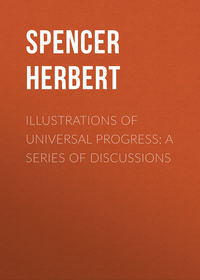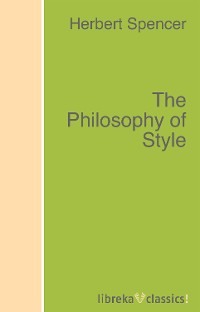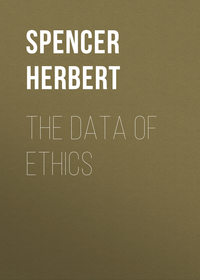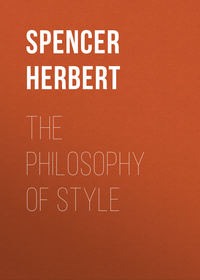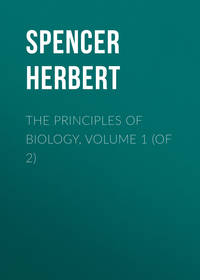 полная версия
полная версияFirst Principles
Thus then by the indestructibility of Matter, we really mean the indestructibility of the force with which Matter affects us. As we become conscious of Matter only through that resistance which it opposes to our muscular energy, so do we become conscious of the permanence of Matter only through the permanence of this resistance; as either immediately or mediately proved to us. And this truth is made manifest not only by analysis of the à posteriori cognition, but equally so by analysis of the à priori one. For that which we cannot conceive to be diminished by the continued compression of Matter, is not its occupancy of space, but its ability to resist.
CHAPTER VII.
THE CONTINUITY OF MOTION
§ 69. Another general truth of the same order with the foregoing, must here be specified – one which, though not so generally recognized, has yet long been familiar among men of science. The continuity of Motion, like the indestructibility of Matter, is clearly an axiom underlying the very possibility of a rational theory of Evolution. That kind of change in the arrangement of parts, which we have found to constitute Evolution, could not be deductively explained were it possible for Motion either to appear or disappear. If those motions through which the parts pass into a new arrangement, might either proceed from nothing or lapse into nothing, there would be an end to scientific interpretation of them. Each constituent change might as well as not be supposed to begin and end of itself.
The axiomatic character of the truth that Motion is continuous, is recognized only after the discipline of exact science has given precision to the conceptions. Aboriginal men, our uneducated population, and even most of the so-called educated, think in an extremely indefinite manner. From careless observations, they pass by careless reasoning, to conclusions of which they do not contemplate the implications – conclusions which they never develope for the purpose of seeing whether they are consistent. Accepting without criticism the dicta of unaided perception, to the effect that surrounding bodies when put in motion soon return to rest, the great majority tacitly assume that the motion is actually lost. They do not consider whether the phenomenon can be otherwise interpreted; or whether the interpretation they put on it can be mentally realized. They are content with a colligation of mere appearances. But the establishment of certain facts having quite an opposite implication, led to inquiries which have gradually proved such appearances to be illusive. The discovery that the planets revolve round the Sun with undiminishing speed, raised the suspicion that a moving body, when not interfered with, will go on for ever without change of velocity; and suggested the question whether bodies which lose their motion, do not at the same time communicate as much motion to other bodies. It was a familiar fact that a stone would glide further over a smooth surface, such as ice, presenting no small objects to which it could part with its motion by collision, than over a surface strewn with such small objects; and that a projectile would travel a far greater distance through a rare medium like air, than through a dense medium like water. Thus the primitive notion that moving bodies had an inherent tendency gradually to lose their motion and finally stop – a notion of which the Greeks did not get rid, but which lasted till the time of Galileo – began to give way. It was further shaken by such experiments as those of Hooke, which proved that the spinning of a top continued long in proportion as it was prevented from communicating movement to surrounding matter – experiments which, when repeated with the aid of modern appliances, have shown that in vacuo such rotation, retarded only by the friction of the axis, will continue for nearly an hour. Thus have been gradually dispersed, the obstacles to the reception of the first law of motion; – the law, namely, that when not influenced by external forces, a moving body will go on in a straight line with a uniform velocity. And this law is in our day being merged in the more general one, that Motion, like Matter, is indestructible; and that whatever is lost by any one portion of matter is transferred to other portions – a conclusion which, however much at variance it seems with cases of sudden arrest from collision with an immovable object, is yet reconciled with such cases by the discovery that the motion apparently lost continues under new forms, though forms not directly perceptible.
§ 70. And here it may be remarked of Motion, as it was before of Matter, that its indestructibility is not only to be inductively inferred, but that it is a necessity of thought: its destructibility never having been truly conceived at all, but having always been, as it is now, a mere verbal proposition that cannot be realized in consciousness – a pseud-idea. Whether that absolute reality which produces in us the consciousness we call Motion, be or be not an eternal mode of the Unknowable, it is impossible for us to say; but that the relative reality which we call Motion never can come into existence, or cease to exist, is a truth involved in the very nature of our consciousness. To think of Motion as either being created or annihilated – to think of nothing becoming something, or something becoming nothing – is to establish in consciousness a relation between two terms of which one is absent from consciousness, which is impossible. The very nature of intelligence, negatives the supposition that Motion can be conceived (much less known) to either commence or cease.
§ 71. It remains to be pointed out that the continuity of Motion, as well as the indestructibility of Matter, is really known to us in terms of force. That a certain manifestation of force remains for ever undiminished, is the ultimate content of the thought; whether reached à posteriori or à priori.
From terrestrial physics let us take the case of sound propagated to a great distance. Whenever we are directly conscious of the causation of sound (namely, when we produce it ourselves), its invariable antecedent is force. The immediate sequence of this force we know to be motion – first, of our own organs, and then of the body which we set vibrating. The vibrations so generated we can discern both through the fingers and through the ears; and that the sensations received by the ears are the equivalents of mechanical force communicated to the air, and by it impressed on surrounding objects, we have clear proof when objects are fractured: as windows by the report of a cannon; or a glass vessel by a powerful voice. On what, then, rests the reasoning when, as occasionally happens under favourable circumstances, men on board a vessel a hundred miles from shore, hear the ringing of church-bells on placing their ears in the focus of the main sail; and when it is inferred that atmospheric undulations have traversed this immense distance? Manifestly, the assertion that the motion of the clapper, transformed into the vibrations of the bell, and communicated to the surrounding air, has propagated itself thus far on all sides, diminishing in intensity as the mass of air moved became greater, is based solely upon a certain change produced in consciousness through the ears. The listeners are not conscious of motion; they are conscious of an impression produced on them – an impression which implies a force as its necessary correlative. With force they begin, and with force they end: the intermediate motion being simply inferred. Again, where, as in celestial physics, the continuity of motion is quantitatively proved, the proof is not direct but inferential; and forces furnish the data for the inference. A particular planet can be identified only by its constant power to affect our visual organs in a special way – to impress upon the retina a group of forces standing in a particular correlation. Further, such planet has not been seen to move by the astronomical observer; but its motion is inferred from a comparison of its present position with the position it before occupied. If rigorously examined, this comparison proves to be a comparison between the different impressions produced on him by the different adjustments of the observing instruments. Going a step further back, it turns out that this difference is meaningless until shown to correspond with a certain calculated position which the planet must occupy, supposing that no motion has been lost. And if, finally, we examine the implied calculation, we find that it makes allowances for those accelerations and retardations which ellipticity of the orbit involves, as well as those variations of velocity caused by adjacent planets – we find, that is, that the motion is concluded to be indestructible not from the uniform velocity of the planet, but from the constant quantity of motion exhibited when allowance is made for the motion communicated to, or received from, other celestial bodies. And when we ask how this communicated motion is estimated, we discover that the estimate is based upon certain laws of force; which laws, one and all, embody the postulate that force cannot be destroyed. Without the axiom that action and re-action are equal and opposite, astronomy could not make its exact predictions; and we should lack the rigorous inductive proof they furnish that motion can never be lost, but can only be transferred.
Similarly with the à priori conclusion that Motion is continuous. That which defies suppression in thought, is really the force which the motion indicates. The unceasing change of position, considered by itself, may be mentally abolished without difficulty. We can readily imagine retardation and stoppage to result from the action of external bodies. But to imagine this, is not possible without an abstraction of the force implied by the motion. We are obliged to conceive this force as impressed in the shape of re-action on the bodies that cause the arrest. And the motion that is communicated to them, we are compelled to regard, not as directly communicated, but as a product of the communicated force. We can mentally diminish the velocity or space-element of motion, by diffusing the momentum or force-element over a larger mass of matter; but the quantity of this force-element, which we regard as the cause of the motion, is unchangeable in thought.
CHAPTER VIII.
THE PERSISTENCE OF FORCE. 12
§ 72. Before taking a first step in the rational interpretation of Evolution, it is needful to recognize, not only the facts that Matter is indestructible and Motion continuous, but also the fact that Force persists. An attempt to assign the causes of Evolution, would manifestly be absurd, if that agency to which the metamorphosis in general and in detail is due, could either come into existence or cease to exist. The succession of phenomena would in such case be altogether arbitrary; and deductive science impossible.
Here, indeed, the necessity is even more imperative than in the two preceding cases. For the validity of the proofs given that Matter is indestructible and Motion continuous, really depends upon the validity of the proof that Force is persistent. An analysis of the reasoning demonstrated that in both cases, the à posteriori conclusion involves the assumption that unchanged quantities of Matter and Motion are proved by unchanged manifestations of Force; and in the à priori cognition we found this to be the essential constituent. Hence, that the quantity of Force remains always the same, is the fundamental cognition in the absence of which these derivative cognitions must disappear.
§ 73. But now on what grounds do we assert the persistence of Force? Inductively we can allege no evidence except such as is presented to us throughout the world of sensible phenomena. No force however, save that of which we are conscious during our own muscular efforts, is immediately known to us. All other force is mediately known through the changes we attribute to it. Since, then, we cannot infer the persistence of Force from our own sensation of it, which does not persist; we must infer it, if it is inferred at all, from the continuity of Motion, and the undiminished ability of Matter to produce certain effects. But to reason thus is manifestly to reason in a circle. It is absurd to allege the indestructibility of Matter, because we find experimentally that under whatever changes of form a given mass of matter exhibits the same gravitation, and then afterwards to argue that gravitation is constant because a given mass of matter exhibits always the same quantity of it. We cannot prove the continuity of Motion by assuming that Force is persistent, and then prove the persistence of Force by assuming that Motion is continuous.
The data of both objective and subjective science being involved in this question touching the nature of our cognition that Force is persistent, it will be desirable here to examine it more closely. At the risk of trying the reader’s patience, we must reconsider the reasoning through which the indestructibility of Matter and the continuity of Motion are established; that we may see how impossible it is to arrive by parallel reasoning at the persistence of Force. In all three cases the question is one of quantity: – does the Matter, or Motion, or Force, ever diminish in quantity? Quantitative science implies measurement; and measurement implies a unit of measure. The units of measure from which all others of any exactness are derived, are units of linear extension. From these, through the medium of the equal-armed lever or scales, we derive our equal units of weight, or gravitative force. And it is by means of these equal units of extension and equal units of weight, that we make those quantitative comparisons by which the truths of exact science are reached. Throughout the investigations leading the chemist to the conclusion that of the carbon which has disappeared during combustion, no portion has been lost, and that in any compound afterwards formed by the resulting carbonic acid the whole of the original carbon is present, what is his repeatedly assigned proof? That afforded by the scales. In what terms is the verdict of the scales given? In grains – in units of weight – in units of gravitative force. And what is the total content of the verdict? That as many units of gravitative force as the carbon exhibited at first, it exhibits still. The quantity of matter is asserted to be the same, if the number of units of force it counter-balances is the same. The validity of the inference, then, depends entirely upon the constancy of the units of force. If the force with which the portion of metal called a grain-weight, tends towards the Earth, has varied, the inference that Matter is indestructible is vicious. Everything turns on the truth of the assumption that the gravitation of the weights is persistent; and of this no proof is assigned, or can be assigned. In the reasonings of the astronomer there is a like implication; from which we may draw the like conclusion. No problem in celestial physics can be solved without the assumption of some unit of force. This unit need not be, like a pound or a ton, one of which we can take direct cognizance. It is requisite only that the mutual attraction which some two of the bodies concerned exercise at a given distance, should be taken as one; so that the other attractions with which the problem deals, may be expressed in terms of this one. Such unit being assumed, the momenta which the respective masses will generate in each other in a given time, are calculated; and compounding these with the momenta they already have, their places at the end of that time are predicted. The prediction is verified by observation. From this, either of two inferences may be drawn. Assuming the masses to be fixed, the motion may be proved to be undiminished; or assuming the motion to be undiminished, the masses may be proved to be fixed. But the validity of one or other inference, depends wholly on the truth of the assumption that the unit of force is unchanged. Let it be supposed that the gravitation of the two bodies towards each other at the given distance, has varied, and the conclusions drawn are no longer true. Nor is it only in their concrete data that the reasonings of terrestrial and celestial physics assume the persistence of Force. They equally assume it in the abstract principle with which they set out; and which they repeat in justification of every step. The equality of action and reaction is taken for granted from beginning to end of either argument; and to assert that action and reaction are equal and opposite, is to assert that Force is persistent. The allegation really amounts to this, that there cannot be an isolated force beginning and ending in nothing; but that any force manifested, implies an equal antecedent force from which it is derived, and against which it is a reaction. Further, that the force so originating cannot disappear without result; but must expend itself in some other manifestation of force, which, in being produced, becomes its reaction; and so on continually. Clearly then the persistence of Force is an ultimate truth of which no inductive proof is possible.
We might indeed be certain, even in the absence of any such analysis as the foregoing, that there must exist some principle which, as being the basis of science, cannot be established by science. All reasoned-out conclusions whatever, must rest on some postulate. As before shown (§ 23), we cannot go on merging derivative truths in those wider and wider truths from which they are derived, without reaching at last a widest truth which can be merged in no other, or derived from no other. And whoever contemplates the relation in which it stands to the truths of science in general, will see that this truth transcending demonstration is the persistence of Force.
§ 74. But now what is the force of which we predicate persistence? It is not the force we are immediately conscious of in our own muscular efforts; for this does not persist. As soon as an outstretched limb is relaxed, the sense of tension disappears. True, we assert that in the stone thrown or in the weight lifted, is exhibited the effect of this muscular tension; and that the force which has ceased to be present in our consciousness, exists elsewhere. But it does not exist elsewhere under any form cognizable by us. It was proved (§ 18), that though, on raising an object from the ground, we are obliged to think of its downward pull as equal and opposite to our upward pull; and though it is impossible to represent these pulls as equal without representing them as like in kind; yet, since their likeness in kind would imply in the object a sensation of muscular tension, which cannot be ascribed to it, we are compelled to admit that force as it exists out of our consciousness, is not force as we know it. Hence the force of which we assert persistence is that Absolute Force of which we are indefinitely conscious as the necessary correlate of the force we know. Thus, by the persistence of Force, we really mean the persistence of some Power which transcends our knowledge and conception. The manifestations, as occurring either in ourselves or outside of us, do not persist; but that which persists is the Unknown Cause of these manifestations. In other words, asserting the persistence of Force, is but another mode of asserting an Unconditioned Reality, without beginning or end.
Thus, quite unexpectedly, we come down once more to that ultimate truth in which, as we saw, Religion and Science coalesce. On examining the data underlying a rational theory of Evolution, we find them all at last resolvable into that datum without which consciousness was shown to be impossible – the continued existence of an Unknowable as the necessary correlative of the Knowable. Once commenced, the analysis of the truths taken for granted in scientific inquiries, inevitably brings us down to this deepest truth, in which Common Sense and Philosophy are reconciled.
The arguments and conclusion contained in this and the foregoing three chapters, supply, indeed, the complement to the arguments and conclusion set forth in the preceding part of this work. It was there first shown, by an examination of our ultimate religious ideas, that knowledge of Absolute Being is impossible; and the impossibility of knowing Absolute Being, was also shown by an examination of our ultimate scientific ideas. In a succeeding chapter a subjective analysis proved, that while, by the very conditions of thought, we are prevented from knowing anything beyond relative being; yet that by these very same conditions of thought, an indefinite consciousness of Absolute Being is necessitated. And here, by objective analysis, we similarly find that the axiomatic truths of physical science, unavoidably postulate Absolute Being as their common basis.
Thus there is even a more profound agreement between Religion and Science than was before shown. Not only are they wholly at one on the negative proposition that the Non-relative cannot be known; but they are wholly at one on the positive proposition that the Non-relative is an actual existence. Both are obliged by the demonstrated untenability of their supposed cognitions, to confess that the Ultimate Reality is incognizable; and yet both are obliged to assert the existence of an Ultimate Reality. Without this, Religion has no subject-matter; and without this, Science, subjective and objective, lacks its indispensable datum. We cannot construct a theory of internal phenomena without postulating Absolute Being; and unless we postulate Absolute Being, or being which persists, we cannot construct a theory of external phenomena.
§ 75. A few words must be added respecting the nature of this fundamental consciousness. Already it has been looked at from several points of view; and here it seems needful finally to sum up the results.
In Chapter IV. we saw that the Unknown Power of which neither beginning nor end can be conceived, is present to us as that unshaped material of consciousness which is shaped afresh in every thought. Our inability to conceive its limitation, is thus simply the obverse of our inability to put an end to the thinking subject while still continuing to think. In the two foregoing chapters, we contemplated this fundamental truth under another aspect. The indestructibility of Matter and the continuity of Motion, we saw to be really corollaries from the impossibility of establishing in thought a relation between something and nothing. What we call the establishment of a relation in thought, is the passage of the substance of consciousness, from one form into another. To think of something becoming nothing, would involve that this substance of consciousness having just existed under a given form, should next assume no form; or should cease to be consciousness. And thus our inability to conceive Matter and Motion destroyed, is our inability to suppress consciousness itself. What, in these two foregoing chapters, was proved true of Matter and Motion, is, à fortiori, true of the Force out of which our conceptions of Matter and Motion are built. Indeed, as we saw, that which is indestructible in matter and motion, is the force they present. And, as we here see, the truth that Force is indestructible, is the obverse of the truth that the Unknown Cause of the changes going on in consciousness is indestructible. So that the persistence of consciousness, constitutes at once our immediate experience of the persistence of Force, and imposes on us the necessity we are under of asserting its persistence.
§ 76. Thus, in all ways there is forced on us the fact, that here is an ultimate truth given in our mental constitution. It is not only a datum of science, but it is a datum which even the assertion of our nescience involves. Whoever alleges that the inability to conceive a beginning or end of the Universe, is a negative result of our mental structure, cannot deny that our consciousness of the Universe as persistent, is a positive result of our mental structure. And this persistence of the Universe, is the persistence of that Unknown Cause, Power, or Force, which is manifested to us through all phenomena.
Such then is the foundation of any possible system of positive knowledge. Deeper than demonstration – deeper even than definite cognition – deep as the very nature of mind, is the postulate at which we have arrived. Its authority transcends all other whatever; for not only is it given in the constitution of our own consciousness, but it is impossible to imagine a consciousness so constituted as not to give it. Thought, involving simply the establishment of relations, may be readily conceived to go on while yet these relations have not been organized into the abstracts we call Space and Time; and so there is a conceivable kind of consciousness which does not contain the truths, commonly called à priori, involved in the organization of these forms of relations. But thought cannot be conceived to go on without some element between which its relations may be established; and so there is no conceivable kind of consciousness which does not imply continued existence as its datum. Consciousness without this or that particular form is possible; but consciousness without contents is impossible.



